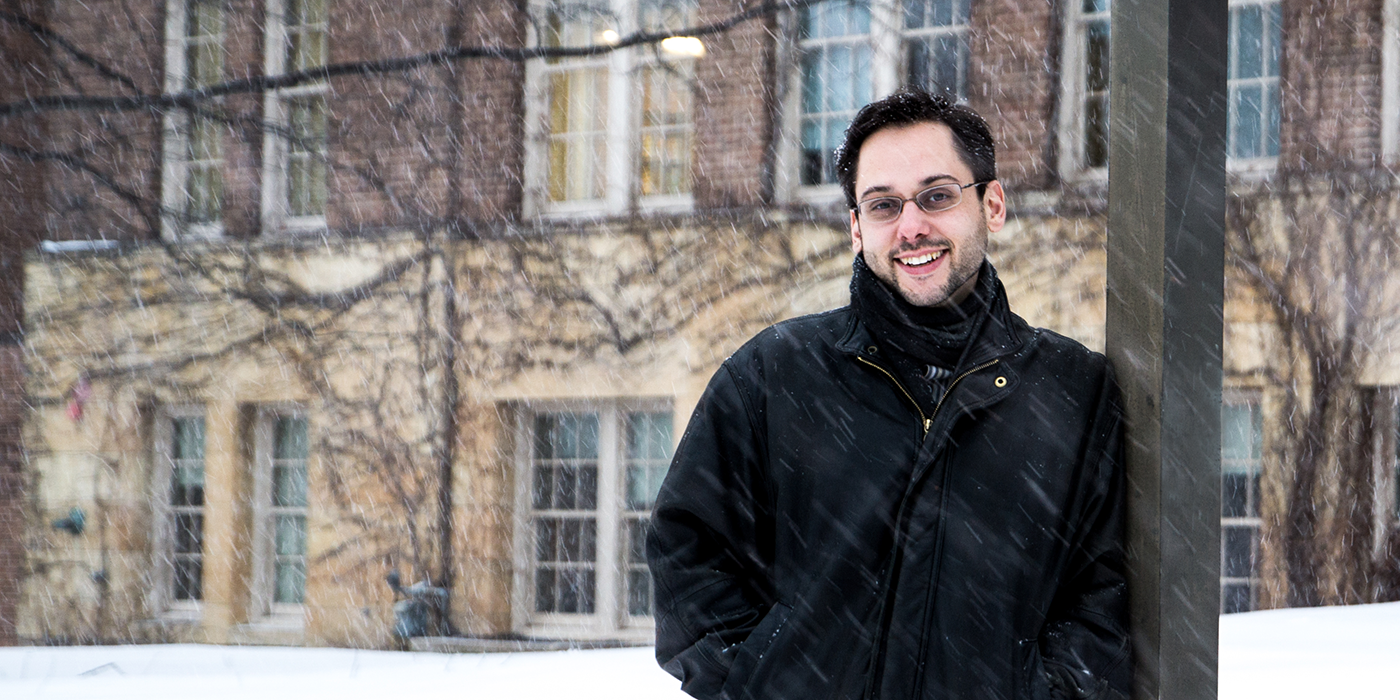New faculty Michael Freeman investigates emergent frontiers in natural product biochemistry.

When humans communicate, we use words. When microbes communicate, they often use small molecules called “natural products”. Today, researchers have a limited idea of how most of these products are made, or even what they might mean. Michael Freeman, a new faculty member in the department of Biochemistry, Molecular Biology, and Biophysics, will focus his research on the curious world of peptide natural products — a fascinating subset of small molecules about which very little is currently known.
From the powder-capped Alpen vistas of Switzerland to the snow-swept agricultural acreage of the St. Paul campus, Freeman recently arrived to his new lab in Gortner, met by all the wonderful flurries of deep Minnesota winter. In Europe, Freeman conducted postdoctoral research at labs in Bonn, Germany and Zürich, Switzerland, investigating the surprising biosynthetic pathways found within a marine sponge native to coastal Japan.
If you think of a peptide natural product as a word, you might think of the “letters” that compose it as amino acids. According to intro text books, there are 20 fundamental amino acids that compose proteins, and proteins get built by tiny molecular complexes called ribosomes. However, as every biologist comes to expect, there are always exceptions to the rule.
Within the sponge Theonella swinhoei are found bizarrely large and exquisitely cytotoxic natural products known as polytheonamides. These peptides have a simple structure, a single helical tube that can punch holes in cell membranes…yet they also bear a strange feature. Every other amino acid in these polymers has been isomerized from its L configuration to its D configuration. They’re like “words” written in a very specialized language that many other types of cells literally can’t stand.
Because of this highly unusual feature, prior decades of researchers have posited that polytheonamides could not be synthesized at the ribosome like “typical” proteins. Rather, they were thought to be assembled by a Non-Ribosomal Peptide Synthetase (NRPS).
Freeman and his collaborators made the opposite assumption. “We took the leap and said, even though this natural product is strange and has all these different pieces, what if it could be produced by the ribosome?”
Through a stroke of luck and a snap of insight, Freeman discovered his answer atop a “metagenome” — the collection of all DNA within an organism, including that of the stuff living inside of it. In this case, an odd, filamentous bacteria Entotheonella factor was living symbiotically within the sponge, but it could not be cultured in the lab. “We found the responsible cluster of genes in the sponge metagenome, and later linked them to Entotheonella,” says Freeman. “It turned out that these polytheonamides were produced by the bacteria’s ribosome, and had almost 50 post translational modifications occur, including the unusual L-to-D amino acid conversions, which was unprecedented.”
At the U of M, Freeman will take his investigation of microbial communication in new directions. “A long distance goal of my research will be figuring out how to genetically manipulate previously uncultured bacteria and to study natural products in their native ecological environments,” he says.
Microbes can be finicky. Not all of them grow nicely in a lab. Plus, when it comes to natural products, there are so many different types of microbial “languages,” with so many unique types of letters, that it’s challenging to figure out which bacteria could be a good expression host for a given compound.
“It's like asking the right organisms to help you,” says Freeman. “You don't know who to ask, so you try to have many different bacteria at hand. Then you can ask them all, is this the language you speak?” He plans to develop specialized protocol for working with natural products in as many as 10 new expression hosts, in addition to continuing his work on novel and rule-breaking biosynthetic pathways.
“I find tremendous value in basic science, and in asking questions and finding answers to the ones you didn't even realize you were asking at the time,” says Freeman, whose work could lead to promising new techniques for biologically producing small molecules. “Chemists do a wonderful job of making very complex molecules, but biology typically does things much more efficiently, renewably, and cheaper.”
“I find tremendous value in basic science, and in asking questions and finding answers to the ones you didn't even realize you were asking at the time.”
— Colleen Smith